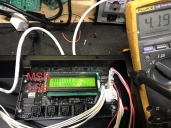I need help with ADS1015 12Bit ADC
I am stumped on something and could use a fresh set of eyes. The ADS1015 is an I2C 12Bit ADC with 4 inputs. I set up the config registers how I want with FSR Full Scale Range 4.096 which means 2mv ( .002V) per LSB. The math is working out correctly at lower inputs. I can take the raw 16 bits data and bitshift right and multiply by .002 and the values are correct. But someone everything above 4.1V is getting chopped off and the MSB+LSB caps at %0111_111_1111. It never gets to 12 bits. I assumed a 12Bit ADC means you get a maximum of 12 bits of resolution!
The ADS1015 has 5V on VDD, with Ferrite bead in series right at the VDD and VSS pins.
The maximum value at an input is VDD+.03, and I'm not getting close to that.
In the photo, you see the meter at just over 4V. The top row is MSB raw bits. The bottom row is LSB raw bits, this needs to be shifted right 4 bits to get rid of unused lowest 4 bits that are all 0's.
If I switch to Full Scale Range 6.144V then the ADC does not get close to maxing out with over 4V inputs. The main thing is why does the ADC stop at 11bits instead of seeing info in the 12th bit too. The decimal 2047 is the maximum I can see.
http://www.ti.com/lit/ds/symlink/ads1015.pdf
The ADS1015 has 5V on VDD, with Ferrite bead in series right at the VDD and VSS pins.
The maximum value at an input is VDD+.03, and I'm not getting close to that.
In the photo, you see the meter at just over 4V. The top row is MSB raw bits. The bottom row is LSB raw bits, this needs to be shifted right 4 bits to get rid of unused lowest 4 bits that are all 0's.
If I switch to Full Scale Range 6.144V then the ADC does not get close to maxing out with over 4V inputs. The main thing is why does the ADC stop at 11bits instead of seeing info in the 12th bit too. The decimal 2047 is the maximum I can see.
PUB ADCCONFIGInput1
' USE 4.096 PGA %001 for .002mV per LSB
ADCconfigHigh := %1_100_000_0 ' OS[15] MUX[14..12] PGA[11..9] = %001= 4.096 Mode[8] one shot
ADCconfigLow := %001_0_0_0_11 ' Data Rate[7..5] CompMode[4] CompPolarity[3] Latch[2] Comp Que [1..0] 11 : Disable comparator
' SEE BELOW FOR CONFIGURING HIGH AND LOW BYTES
' MUX SHOULD BE 100 : AINP= AIN0 and AINN = GND for Motor1 Current Sense
' at INA138 inputs
' PGA gain 001= 4.096 Highest 000= 6.144 010= 2.0148 Low
' A D C C O N F I G B Y T E S
' OS[15] 1 Start a single conversion
' MUX Inputs MUX[14..12]
' 100 Single input 0-GND <<<<<<<<#################
' 101 Single input 1-GND <<<<<<<<#################
' 110 Single input 2-GND
' 111 Single input 3-GND
' PGA gain PGA[11..9]
' 000 Highest gain 6.144 3mV per LSB TOO HIGH 1200 binary
' 001 Highest gain 4.096 2mV per LSB BEST .2V = 1600 binary <<<<<< YES>>>>>>>
' 010 2.048 too low 1 mV per LSB
' 011 1.024 0.5 mV
' 100 .512 0.25 mV
' 101 .256 0.125 mV
' Mode[8] 0 = continuous
' Data Rate 100 = default = 1600 /SPS 001= 250 SPS / 010=490 / 011=920SPS / 000=128SPS /
'MAX Voltage on inputs 0-3 ADC = VDD + .3 or 5.3V
PUB ADCRead
' A D C R E A D ADC V A L U E
i2c1.i2cstart(i2cSCL2) ' START
I2C1.I2CWrite(i2cSCL2, %10010000 + 1) ' send device + READ mode 0 = WRITE 1 = READ
ADC1 := i2c1.i2cRead(i2cSCL2, 0) ' read conversion MSB
ADC2 := i2c1.i2cRead(i2cSCL2, 1) ' read conversion LSB
i2c1.i2cstop(i2cSCL2) ' STOP
' A D C Combine result High Byte + Low Byte 12 Bit Result XXXX_XXXX HIgh XXXX_0000 LOW
ADCsum := ( (ADC1 << 8) + ADC2 ) ' >> 4
' A D C Show Result
CLS
'go(0,0)
ser.bin(3, ADC1, 8)
go(1,0)
ser.bin(3, ADC2, 8)
'ser.bin(3, ADCsum, 12)
go(1,9)
ser.decf(3, ADCsum , 5)
w(5_000_000)
{
Depending on the Full Scale you select, the measured voltage in binary will get multiplied by the LSB value to get the actual voltage it measured
6.144 = LSB = 3mV Default
4.096 = LSB = 2mV Maybe use this. Input cannot exceed 5V VCC
2.048 = LSB = 1mV
1.024 = LSB = .5mV
}
PUB ADCUpdateReg
'1 Create 2 bytes for config based input 0 - 1, Full Scale Range for inputs 0 -1
'2 Select the Config register to write to ( 01) then write the ADC Config bytes
'3 Then select the conversion register since we will NEXT be reading ADC values
' A D C WRITE CONFIG (SELECT Input to Read 0-3) MUST set the CONFIG based on which input to read
i2c1.i2cstart(i2cSCL2) ' START
I2C1.I2CWrite(i2cSCL2, %10010000 + 0) ' send device + write mode 0 = WRITE 1 = READ
I2C1.I2CWrite(i2cSCL2, %01) ' Select register 00 : Conversion register 01 : Config register
I2C1.I2CWrite(i2cSCL2, ADCconfigHigh ) ' Send Config byte HIGH
I2C1.I2CWrite(i2cSCL2, ADCconfigLow ) ' Send Config byte LOW
i2c1.i2cstop(i2cSCL2) ' STOP
' A D C WRITE CONVERSION REGISTER (Tell Device which register we are working with = READ ADC CONVERSIONS)
i2c1.i2cstart(i2cSCL2) ' START
I2C1.I2CWrite(i2cSCL2, %10010000 + 0) ' send device + write mode 0 = WRITE 1 = READ
I2C1.I2CWrite(i2cSCL2, %00) ' Select register 00 : Conversion register 01 : Config register
i2c1.i2cstop(i2cSCL2) ' STOP
http://www.ti.com/lit/ds/symlink/ads1015.pdf



Comments
I use the ADS1115, which is the 16 bit version. It's full scale range is 15 bits in single ended mode. It might be a good drop-in upgrade for your setup if you need the extra bit(s) of resolution.
Perhaps this thread may help you, or maybe not.
https://forums.parallax.com/discussion/160328/configuring-a-programmable-gain-amplifier-on-an-adc